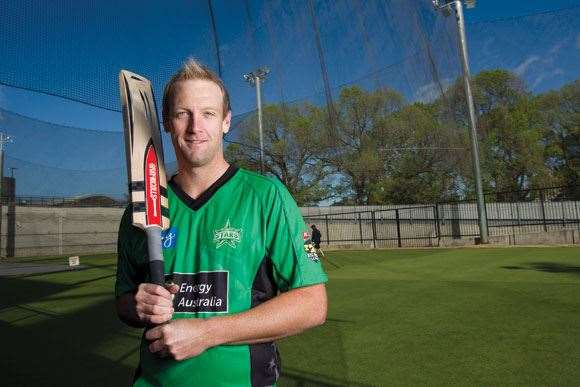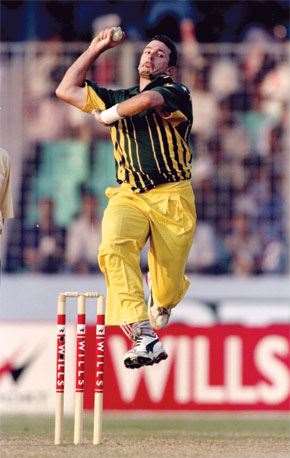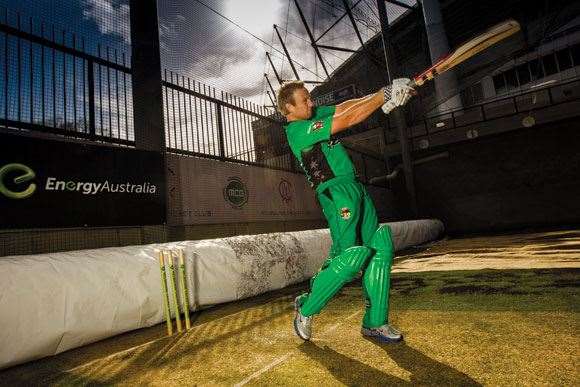White takes us through a typical T20 training day, whatever that might be ...
 Photos by Joseph Feil
Photos by Joseph FeilWhite takes us through a typical T20 training day, whatever that might be ...
Love it for its thrill-a-minute nature, or loathe it for the same reason, it appears Twenty20 is here to stay. Indeed, the more of it that’s played, the stronger the cricketing world’s craving for this shortened form of the game: be it from a financially satisfied player base’s standpoint, that of the owners of newly created franchises, TV execs, or fans young and old – particularly young.
Despite hitting our shores the best part of a decade ago, T20 is still very much an untamed, always-changing beast, suited to only the most agile, attacking and sharp-focussed of today’s elite and emerging talent. Cameron White, 29, of the Melbourne Stars’ Big Bash League troupe, enters this year’s domestic campaign having belted 479 runs for the Deccan Chargers in the most recent Indian Premier League at an average of 43. Australian cricket fans have also been enjoying his handy spin bowling since his 2008 Test debut, three years after his initial international ODI appearance.
In these pages, White takes us through a typical T20 training day, whatever that might be ...
CONSTANT CHANGE
“As the game of Twenty20 has evolved and players’ skills have improved, bowlers have had to think up new deliveries. It’s the same for batsmen, who’ve had to adjust to these new deliveries and work out how to up the scoring rate – mostly using new and clever shots. I think the shorter game is always finding ways to improve itself.”
NO TIME TO WASTE
“These days, players are swapping and changing between the various formats of the game all the time. This year, for example, a player in the Sheffield Shield might be playing four-day cricket, then he’ll find himself having only a seven-to-nine day break between the end of his Shield match and his next Twenty20 Big Bash game. It’s a case of preparing within whatever window of time you’ve been presented with.”
 Photos by Joseph Feil
Photos by Joseph FeilFAST WORK
“The basic fundamentals of each form of the game are very similar, obviously, but Twenty20 demands that more specific skills be practised and worked on at training a bit more. Just like you’d practise your forward defence for Sheffield Shield or Test cricket, basically you have to practise hitting sixes to improve as a T20 batsman. There are specific skills with both bat and ball which have to be built and maintained into order to get the most out of yourself as a T20 player.
“I’m not just referring to areas like shot selection, but the actual T20-specific type of shot which you might work on. Obviously some of the ‘trick’ shots which are around in the shorter format these days ‒ the paddle sweep, your reverse sweeps, over-the-keeper ramp-type shots ‒ are things you don’t see in even one-day cricket, really.”
20 TIMES THE FUN
“My enthusiasm for Twenty20 mirrors that of the many young people ‒ and their mums and dads ‒ who are coming to watch the game in greater numbers. Some big features are that it doesn’t go for as long, it’s more entertaining; it’s jam-packed full of action over three hours. It appeals to the players as much as it does to the people who come and watch it. From a batsman’s viewpoint, it’s a great game when everything is going for you. Then, if the momentum is going the other way, it’s quite hard to wrestle it back sometimes.”
SPECIFIC SKILLS
“All players complete net sessions throughout the season, but when it comes to T20, the focus becomes more specific and concentrates on the core skills needed for the shortened form. As a batter, you’ll train in the nets as you probably would for any game; but you’re looking to ramp up your intensity straight away, to hit the ball harder and score quickly ‒ more big hitting, more high-risk shots ... Very specific stuff that’s individual to each batter, building on whichever strengths they have.
“It’s no different from a bowler’s point of view. You’ll start off with your basic stuff. Then, obviously, you go into each T20 match with a range of deliveries; from slower balls, yorkers – both wide and straight. Then there’s slower-ball bouncers. There’s a variety of balls which you’d probably go to as a bowler – compared to ‘line and length’ and the odd bouncer like in Tests.”
 Photos by Joseph Feil
Photos by Joseph FeilEXPRESSION SESSION
“When you’re facing bowling in the nets, you have to have a very clear mind. You just react to the ball and look to play accordingly. For T20, you might really hone in on particular shots with some throw-downs, some drill work – where a coach or someone can throw you a ball in a certain spot – or face a bowling machine, which you use to deliver a ball in a certain spot over and over. In terms of facing actual bowling, you’re looking to watch the ball and play properly a bit more, but with a bit more freedom and flair for T20.
“A team Twenty20 nets session will last for quite a while. By the time everyone has their bat and bowl and you do your fielding session, you’re looking at two-three hours’ work. Then again, if you’ve done quite a lot of prep throughout the week in the lead-up to a Twenty20 game, your hours might lessen the day before to make sure you’re fresh and up and going and really energised for the game. It’s hard to be really specific about how much time is spent in the nets. There are a lot of variables.”
NET GAIN
“Bowling in Twenty20 is about bowling to certain situations – what’s required at a particular stage of the game is how you bowl. As a bowler, you need to be able to perform in any circumstance, really. If you’re bowling in the first six overs, you need to be able to take wickets and at the same time you need to be able to – if you’re under the pump and the opposition is batting well – bowl very defensively and stop them from scoring. It can be quite difficult to cover all bases while trying to limit the damage the other team is doing with the bat.”
IN THE FIELD
“Compared to the longer forms of the game, obviously there are a lot more big shots played in Twenty20, which means you’d probably do a lot more higher and longer catching practice than for the other formats. There’s a big emphasis on fielding in T20. More often that not, the best fielding team wins the game; there’s a fair emphasis on run-outs and saving runs.
“Most players in the modern era know what position or particular area they’re fielding in these days, whether they’re an infielder or an outfielder; whether they need to practise their hitting-the-stumps to run people out.
“There’s a fair bit of repetition in catching drills and practice, that’s for sure. From different angles, running in from different directions, getting balls hit over your head, to the side ... You just want to tick off and make sure that when you go out to play in a game, you’re feeling confident that you – if the ball comes to you from any direction – can get your hands on it and you can catch it or make the play to make the run out or stop it cleanly so that you don’t fumble it and the opposition gets another run.”
‒ James Smith
Related Articles

Luck of the Draw

Harman hails lookalike Ponting as 'handsome fella'













